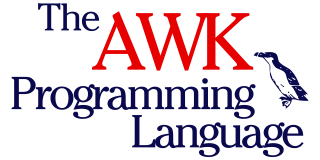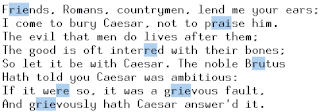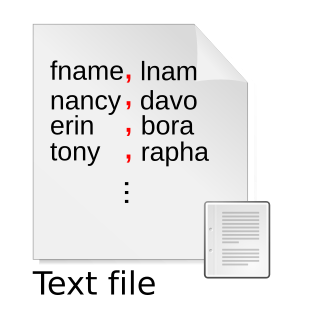Related Research Articles

AWK is a domain-specific language designed for text processing and typically used as a data extraction and reporting tool. Like sed and grep, it is a filter, and is a standard feature of most Unix-like operating systems.

A regular expression, sometimes referred to as rational expression, is a sequence of characters that specifies a match pattern in text. Usually such patterns are used by string-searching algorithms for "find" or "find and replace" operations on strings, or for input validation. Regular expression techniques are developed in theoretical computer science and formal language theory.

sed is a Unix utility that parses and transforms text, using a simple, compact programming language. It was developed from 1973 to 1974 by Lee E. McMahon of Bell Labs, and is available today for most operating systems. sed was based on the scripting features of the interactive editor ed and the earlier qed. It was one of the earliest tools to support regular expressions, and remains in use for text processing, most notably with the substitution command. Popular alternative tools for plaintext string manipulation and "stream editing" include AWK and Perl.

The C shell is a Unix shell created by Bill Joy while he was a graduate student at University of California, Berkeley in the late 1970s. It has been widely distributed, beginning with the 2BSD release of the Berkeley Software Distribution (BSD) which Joy first distributed in 1978. Other early contributors to the ideas or the code were Michael Ubell, Eric Allman, Mike O'Brien and Jim Kulp.
A string literal or anonymous string is a literal for a string value in the source code of a computer program. Modern programming languages commonly use a quoted sequence of characters, formally "bracketed delimiters", as in x = "foo", where "foo" is a string literal with value foo. Methods such as escape sequences can be used to avoid the problem of delimiter collision and allow the delimiters to be embedded in a string. There are many alternate notations for specifying string literals especially in complicated cases. The exact notation depends on the programming language in question. Nevertheless, there are general guidelines that most modern programming languages follow.
In computer programming, glob patterns specify sets of filenames with wildcard characters. For example, the Unix Bash shell command mv *.txttextfiles/ moves all files with names ending in .txt from the current directory to the directory textfiles. Here, * is a wildcard and *.txt is a glob pattern. The wildcard * stands for "any string of any length including empty, but excluding the path separator characters ".
The backtick` is a typographical mark used mainly in computing. It is also known as backquote, grave, or grave accent.

A delimiter is a sequence of one or more characters for specifying the boundary between separate, independent regions in plain text, mathematical expressions or other data streams. An example of a delimiter is the comma character, which acts as a field delimiter in a sequence of comma-separated values. Another example of a delimiter is the time gap used to separate letters and words in the transmission of Morse code.
In some programming languages, eval, short for the English evaluate, is a function which evaluates a string as though it were an expression in the language, and returns a result; in others, it executes multiple lines of code as though they had been included instead of the line including the eval. The input to eval is not necessarily a string; it may be structured representation of code, such as an abstract syntax tree, or of special type such as code. The analog for a statement is exec, which executes a string as if it were a statement; in some languages, such as Python, both are present, while in other languages only one of either eval or exec is.
In computer programming, a one-liner program originally was textual input to the command line of an operating system shell that performed some function in just one line of input. In the present day, a one-liner can be
In computer programming, a sigil is a symbol affixed to a variable name, showing the variable's datatype or scope, usually a prefix, as in $foo, where $ is the sigil.

The syntax of the Python programming language is the set of rules that defines how a Python program will be written and interpreted. The Python language has many similarities to Perl, C, and Java. However, there are some definite differences between the languages. It supports multiple programming paradigms, including structured, object-oriented programming, and functional programming, and boasts a dynamic type system and automatic memory management.
In computer programming, leaning toothpick syndrome (LTS) is the situation in which a quoted expression becomes unreadable because it contains a large number of escape characters, usually backslashes ("\"), to avoid delimiter collision.
This comparison of programming languages compares the features of language syntax (format) for over 50 computer programming languages.
The less-than sign is a mathematical symbol that denotes an inequality between two values. The widely adopted form of two equal-length strokes connecting in an acute angle at the left, <, has been found in documents dated as far back as the 1560s. In mathematical writing, the less-than sign is typically placed between two values being compared and signifies that the first number is less than the second number. Examples of typical usage include 1⁄2 < 1 and −2 < 0.
A batch file is a script file in DOS, OS/2 and Microsoft Windows. It consists of a series of commands to be executed by the command-line interpreter, stored in a plain text file. A batch file may contain any command the interpreter accepts interactively and use constructs that enable conditional branching and looping within the batch file, such as IF, FOR, and GOTO labels. The term "batch" is from batch processing, meaning "non-interactive execution", though a batch file might not process a batch of multiple data.
In computing, command substitution is a facility that allows a command to be run and its output to be pasted back on the command line as arguments to another command. Command substitution first appeared in the Bourne shell, introduced with Version 7 Unix in 1979, and has remained a characteristic of all later Unix shells. The feature has since been adopted in other programming languages as well, including Perl, PHP, Ruby and Microsoft's Powershell under Windows. It also appears in Microsoft's CMD.EXE in the FOR command and the ( ) command.
The structure of the Perl programming language encompasses both the syntactical rules of the language and the general ways in which programs are organized. Perl's design philosophy is expressed in the commonly cited motto "there's more than one way to do it". As a multi-paradigm, dynamically typed language, Perl allows a great degree of flexibility in program design. Perl also encourages modularization; this has been attributed to the component-based design structure of its Unix roots, and is responsible for the size of the CPAN archive, a community-maintained repository of more than 100,000 modules.
In computer programming, string interpolation is the process of evaluating a string literal containing one or more placeholders, yielding a result in which the placeholders are replaced with their corresponding values. It is a form of simple template processing or, in formal terms, a form of quasi-quotation. The placeholder may be a variable name, or in some languages an arbitrary expression, in either case evaluated in the current context.
The syntax of the Ruby programming language is broadly similar to that of Perl and Python. Class and method definitions are signaled by keywords, whereas code blocks can be defined by either keywords or braces. In contrast to Perl, variables are not obligatorily prefixed with a sigil. When used, the sigil changes the semantics of scope of the variable. For practical purposes there is no distinction between expressions and statements. Line breaks are significant and taken as the end of a statement; a semicolon may be equivalently used. Unlike Python, indentation is not significant.
References
- 1 2 "Here-Document description in the POSIX/SUS standard". Archived from the original on 2014-04-27. Retrieved 2018-04-20.
- ↑ "Here document - Rosetta Code". rosettacode.org. Archived from the original on 2020-06-29. Retrieved 2017-02-20.
- 1 2 "Darwin tcsh man page". Archived from the original on 2019-07-01. Retrieved 2018-04-20.
- ↑ Wayne Pollock. "Shell Here Document Overview". hccfl.edu. Archived from the original on 2014-05-29. Retrieved 2014-05-28.
- ↑ 3.6.6 Here Documents
- ↑ See for example Using variables inside a bash heredoc
- ↑ "perldata: Special Literals". Archived from the original on 2017-12-23. Retrieved 2013-08-31.
- ↑ Ruby: Object: __END__ Archived 2017-07-11 at the Wayback Machine
- ↑ "Perl operators and precedence". Archived from the original on 2012-07-17. Retrieved 2010-05-22.
- ↑ "Perl5260delta - what is new for perl v5.26.0 - Perldoc Browser". Archived from the original on 2024-05-13. Retrieved 2018-12-21.
- ↑ "Heredoc in PHP manual". php.net. Archived from the original on 2012-07-12. Retrieved 2011-04-06.
- ↑ "PHP: Strings - Manual". php.net. Archived from the original on 2012-07-03. Retrieved 2011-09-07.
- ↑ "JEP 378: Text Blocks". openjdk.org. Retrieved 2024-06-05.
- ↑ "Text Blocks (JEP 378) - javaalmanac.io". javaalmanac.io. Retrieved 2024-06-05.
- ↑ "Here string in Racket Documentation". Archived from the original on 2011-09-03. Retrieved 2011-09-17.
- ↑ "@ Syntax in Racket Documentation". Archived from the original on 2012-01-22. Retrieved 2011-09-17.
- ↑ "HP OpenVMS DCL Dictionary". Archived from the original on 2016-03-04. Retrieved 2015-04-21.